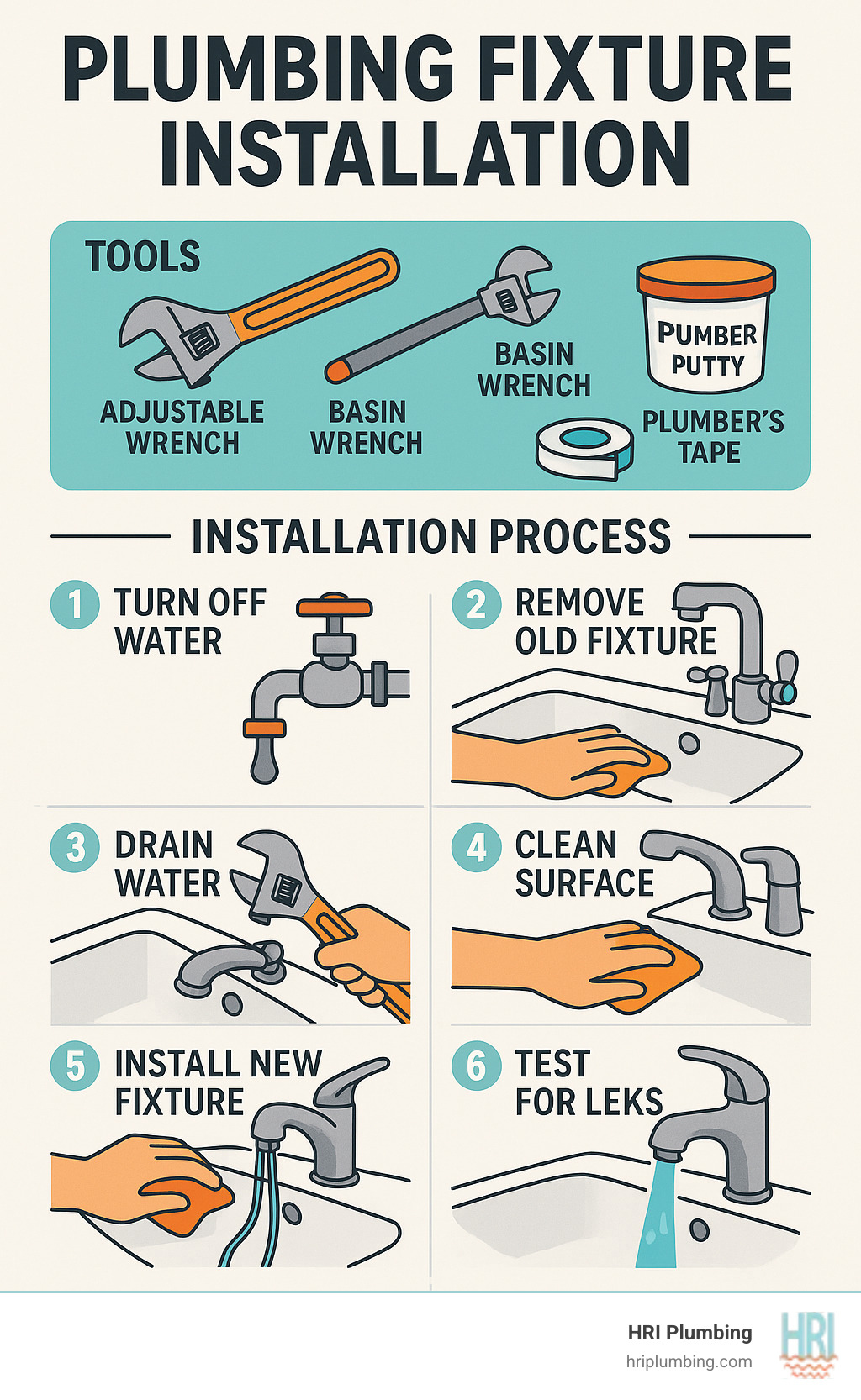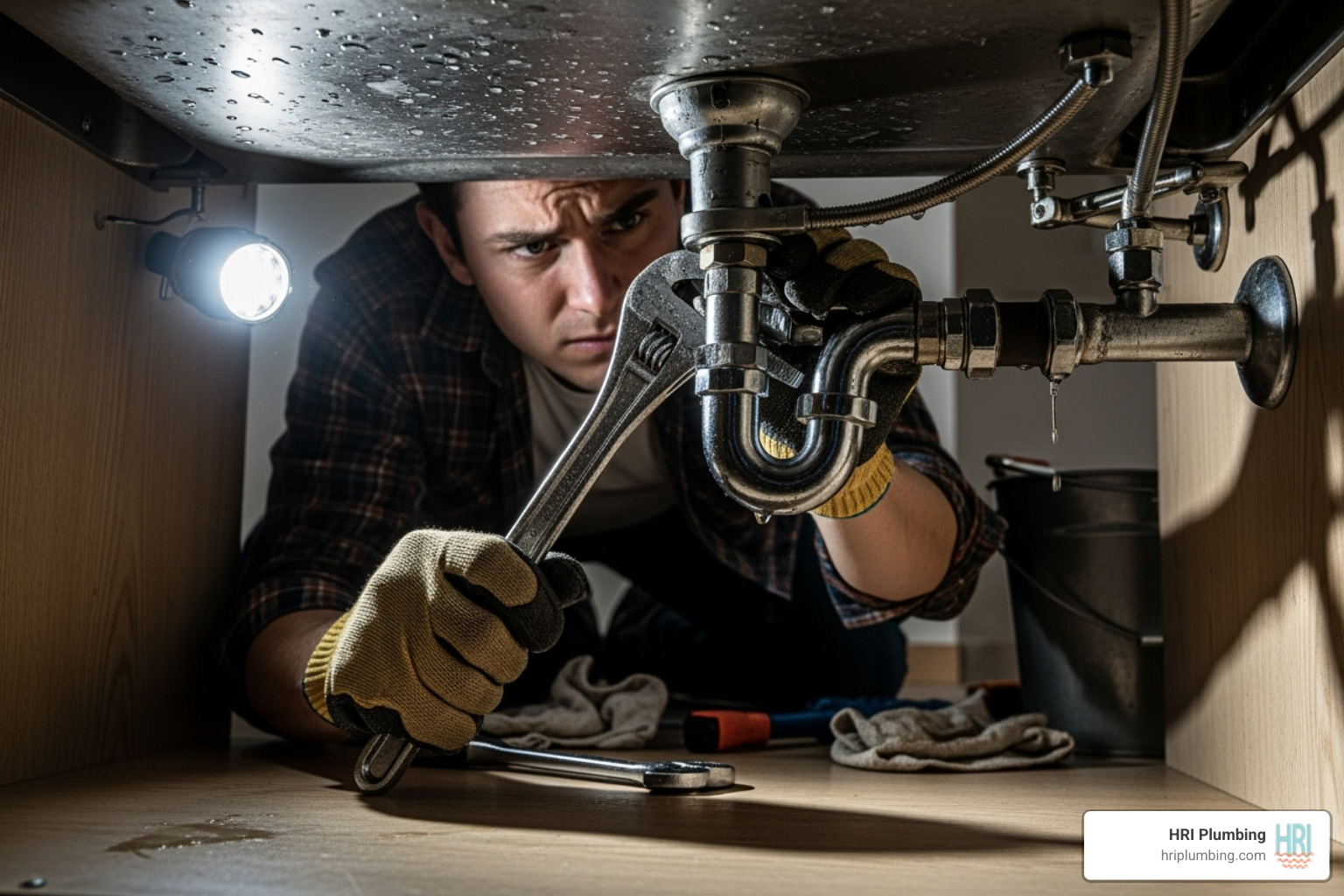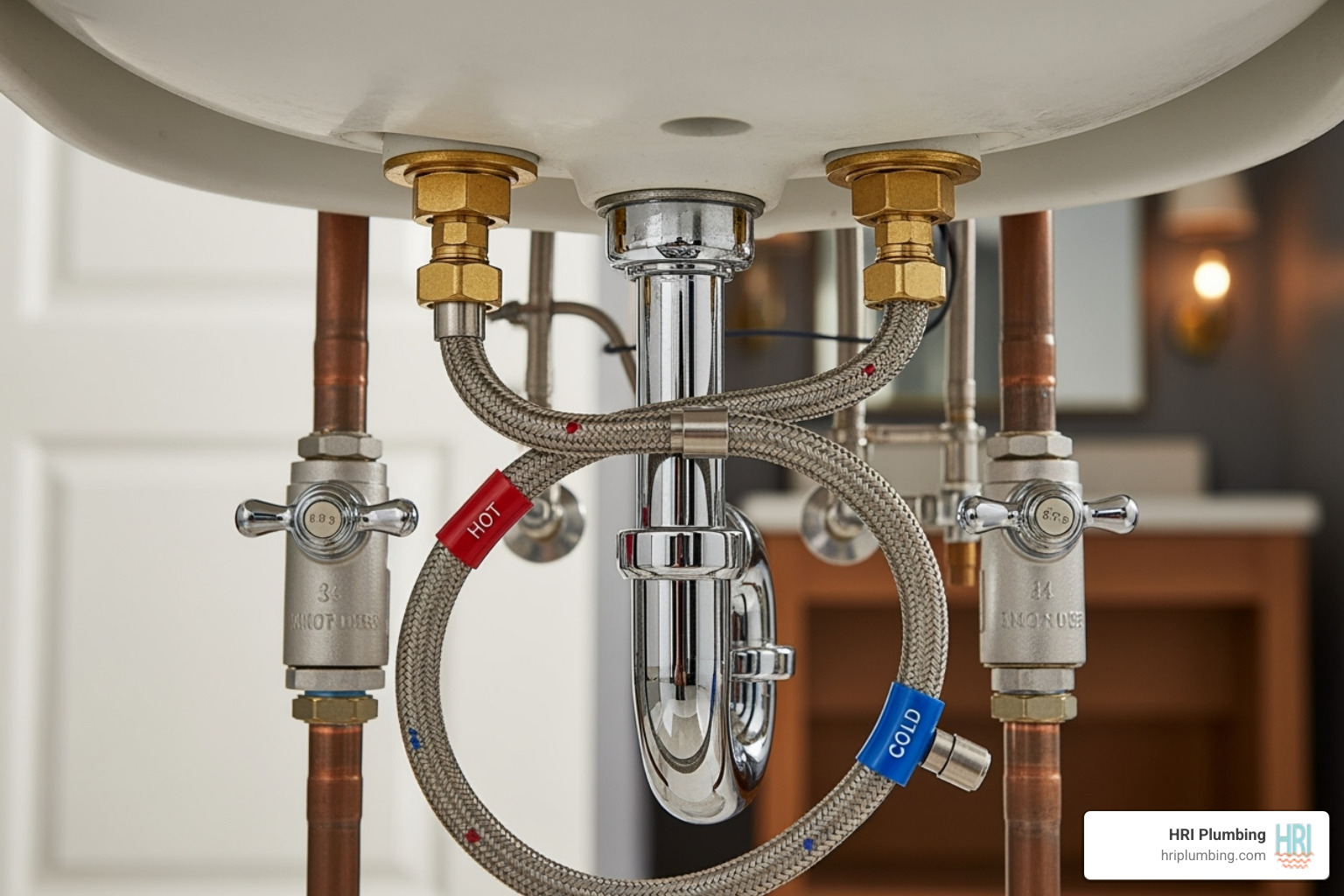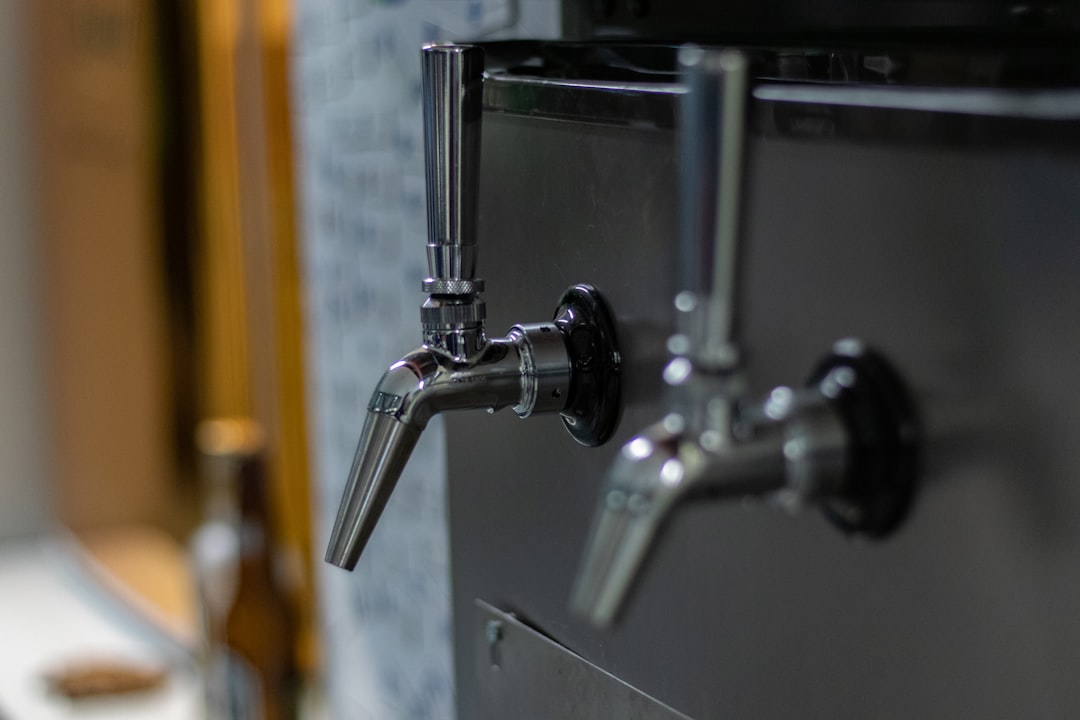Getting Started: Prepping for Your Plumbing Project
A new plumbing fixture installation can transform your bathroom or kitchen. Whether you're replacing a leaky faucet or upgrading to a water-efficient model, understanding the basics will help you tackle the project with confidence.
Essential Steps for Plumbing Fixture Installation:
- Turn off water supply at shut-off valves or the main line.
- Drain remaining water from pipes and fixtures.
- Remove the old fixture by loosening mounting nuts.
- Clean the installation surface thoroughly.
- Install the new fixture following manufacturer instructions.
- Connect supply lines with the proper fittings.
- Test for leaks after turning the water back on.
Most homeowners can install basic fixtures like faucets and showerheads. A sink faucet installation typically takes a couple of hours for beginners, while shower or bathtub fixtures may require at least half a day. The key is proper preparation and having the right tools. However, if you're dealing with corroded pipes, need to move water lines, or encounter persistent leaks, it's time to call an expert like HRI Plumbing.

Understanding Your Plumbing System
Before you begin a plumbing fixture installation, it helps to know the basics of your system.
- Water Supply Lines: These pipes bring fresh water into your home and to your fixtures.
- Drain Lines: These pipes use gravity to carry wastewater away from your fixtures.
- Vent Stacks: Extending through the roof, these pipes regulate air pressure in the drain lines, preventing gurgles and odors.
- P-Traps: The U-shaped pipe under each sink holds water to block sewer gases from entering your home.
Proper pipe sizing is crucial for ensuring adequate water pressure and drainage, a concept professionals measure using Plumbing Fixture Units (PFUs). For a deeper dive, you can explore a deeper look at what a plumbing fixture is.
Gathering Your Tools and Choosing Your Fixture
A well-prepared workspace and the correct tools are half the battle.
Here’s our essential toolkit:
- Adjustable Wrench
- Basin Wrench (for tight spaces under sinks)
- Pliers
- Screwdriver Set
- Plumber's Tape (PTFE Tape)
- Plumber's Putty
- Bucket and Towels
- Silicone Caulk
When choosing a new fixture, consider these factors:
- Functionality: Does it meet your daily needs, like a high-arc kitchen faucet for large pots?
- Water Efficiency: Look for WaterSense® labeled fixtures to save water and money.
- Style: Ensure the finish and design complement your room's decor.
- Compatibility: Check that the new fixture matches your sink's hole configuration and, for showers, the existing valve type. Measure the space to ensure a proper fit.
Choosing wisely upfront saves headaches later. For more tips on integrating new fixtures, see our guide on Essential Plumbing Considerations for Home Remodeling.
Your Guide to DIY Plumbing Fixture Installation
Now that you have your tools and fixture, it's time to begin the plumbing fixture installation. Most projects follow a logical sequence, but always start with these universal first steps.

First, shut off the water supply. Use the small shut-off valves under the fixture or the main water supply for your home. Next, drain the lines by opening the faucet to release any remaining water. Have a bucket ready as you remove the old fixture. This often involves disconnecting supply lines and loosening mounting nuts from underneath—a job for your basin wrench. Finally, clean the surface thoroughly to remove old putty and grime, ensuring a perfect seal for your new fixture.
Step-by-Step Bathroom Faucet Installation
Installing a new bathroom faucet is a rewarding DIY project. It's a noticeable upgrade that can be done in just a few hours.

Always start by reading the manufacturer's instructions. Attach the supply lines to the faucet body before mounting it. If your faucet has a deck plate, install it now, using a thin bead of silicone caulk underneath for a watertight seal. Carefully position the faucet by threading its supply lines through the sink holes.
From below, slide on the provided gaskets and tighten the mounting nuts with your basin wrench until the faucet is secure but not over-tightened. Connect the supply lines to the shut-off valves (hot on the left, cold on the right). Use plumber's tape on threaded connections that don't have a rubber seal, and tighten with an adjustable wrench.
Install the pop-up drain assembly by setting the drain body in the sink's drain hole with plumber's putty around the rim. Connect the pivot and lift rods, and test that the drain opens and closes smoothly. Finally, test for leaks by slowly turning the water back on and inspecting every connection. A small drip can usually be fixed by slightly tightening the connection.
For more tips on faucet issues, see our guide on Helpful Tips for Dealing with a Leaky Faucet.
Tackling Shower and Tub Plumbing Fixture Installation
Shower and tub fixture installations are more complex and time-consuming. Replacing a shower valve, in particular, requires careful planning.
The biggest challenge is access, as the shower valve is behind the wall. If there's no access panel, you may need to cut into the wall. When replacing the valve, you'll need to disconnect the water lines. An internal pipe wrench can be essential for removing a stubborn tub spout nipple.
Pay close attention to wall depth consideration when installing the new valve. It must be positioned so the trim sits flush against the finished wall (tile or surround). For best performance, consider running dedicated 3/4-inch supply lines to your shower to ensure consistent water pressure.
Sealing connections is critical since leaks will be hidden inside the wall. Use plumber's tape on all threaded connections for the shower arm and tub spout, and apply silicone caulk around the tub spout nipple. Install the valve's cartridge according to the manufacturer's instructions. Before closing the wall, test for leaks by capping the outlets, turning on the water, and inspecting every connection.
If you suspect issues with your current setup, our article on Signs You Could Have a Faulty Shower Valve can help you diagnose the problem.
Knowing Your Limits and Finishing the Job
You've completed your plumbing fixture installation, which is a significant accomplishment. However, even the most capable DIYer knows when to call for backup. Recognizing your limits is a mark of wisdom, not defeat.
When to Call a Professional
While many fixture installations are manageable, some situations require a licensed plumber. Consider calling an expert if you encounter any of the following:
- Complex Rerouting: The project requires moving supply lines or reconfiguring drain lines, which involves advanced skills and knowledge of plumbing codes.
- Old or Corroded Pipes: Attaching new fixtures to brittle, outdated pipes (like lead or galvanized steel) risks causing a much bigger problem.
- Major Leaks and Water Damage: If a leak has already caused damage, a professional can assess the extent of the problem and ensure all necessary repairs are made before installing the new fixture.
- No Shut-Off Valves: If you lack local shut-off valves for the fixture, a plumber can install them, making future repairs much more convenient.
- Permits and Inspections: Major plumbing changes often require permits. A professional plumber will ensure your project meets all local building codes.
- Lack of Time or Confidence: If you feel overwhelmed or simply don't have the specialized tools, hiring a professional is a smart investment that guarantees the job is done right the first time.
At HRI Plumbing, we provide reliable, high-quality plumbing solutions when a DIY project hits a snag. For a deeper look at the benefits of hiring an expert, read our article on Why Hire a Professional Plumbing Company. If you've received a high estimate elsewhere, we encourage you to get a second opinion on costly plumbing service estimates. For complex projects or if you encounter issues, our experts in Rochester are ready to help with all your plumbing services.












